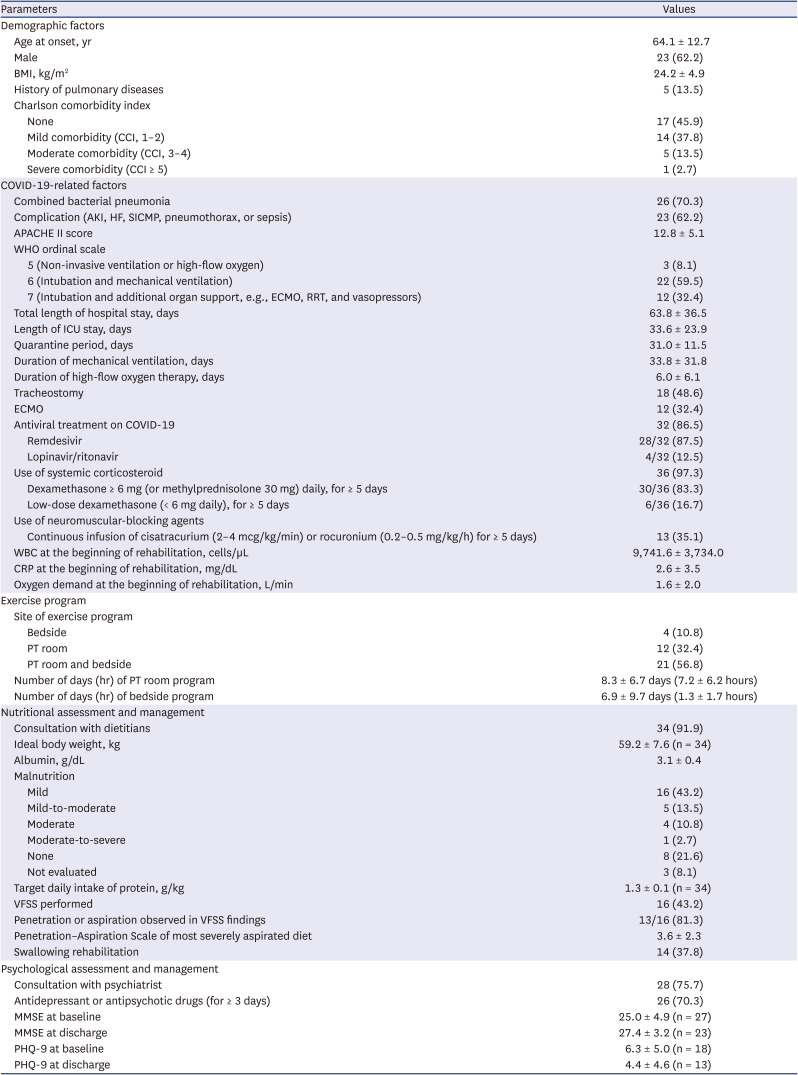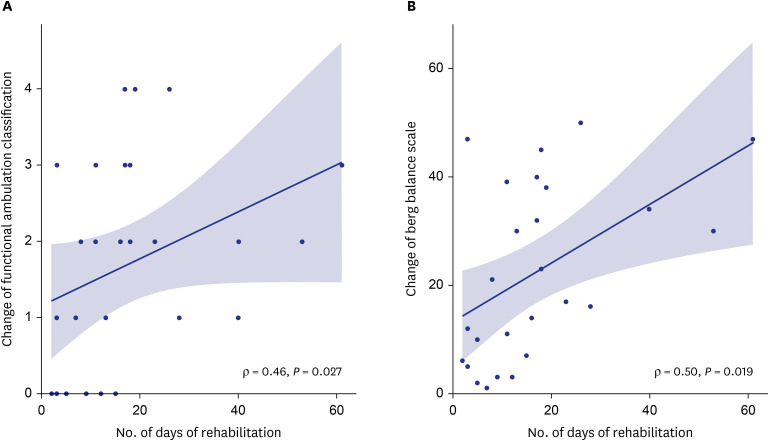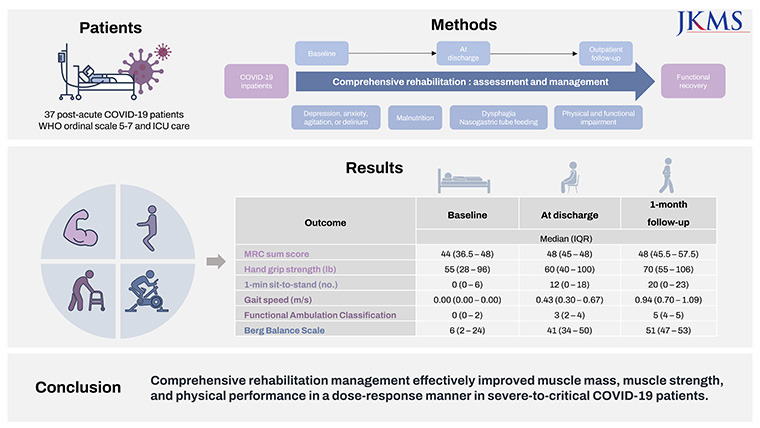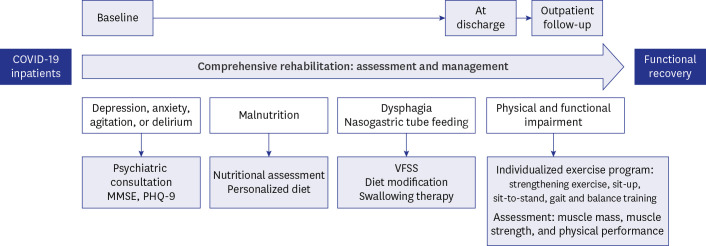1. Zhu N, Zhang D, Wang W, Li X, Yang B, Song J, et al. A novel coronavirus from patients with pneumonia in China, 2019. N Engl J Med. 2020; 382(8):727–733. PMID:
31978945.

2. Wu Z, McGoogan JM. Characteristics of and important lessons from the coronavirus disease 2019 (COVID-19) outbreak in China: summary of a report of 72 314 cases from the Chinese Center for Disease Control and Prevention. JAMA. 2020; 323(13):1239–1242. PMID:
32091533.

3. Pascarella G, Strumia A, Piliego C, Bruno F, Del Buono R, Costa F, et al. COVID-19 diagnosis and management: a comprehensive review. J Intern Med. 2020; 288(2):192–206. PMID:
32348588.

4. Feng Y, Ling Y, Bai T, Xie Y, Huang J, Li J, et al. COVID-19 with different severities: a multicenter study of clinical features. Am J Respir Crit Care Med. 2020; 201(11):1380–1388. PMID:
32275452.

5. Guan WJ, Ni ZY, Hu Y, Liang WH, Ou CQ, He JX, et al. Clinical characteristics of coronavirus disease 2019 in China. N Engl J Med. 2020; 382(18):1708–1720. PMID:
32109013.

6. Sung HK, Kim JY, Heo J, Seo H, Jang YS, Kim H, et al. Clinical course and outcomes of 3,060 patients with coronavirus disease 2019 in Korea, January–May 2020. J Korean Med Sci. 2020; 35(30):e280. PMID:
32743995.

7. Herridge MS, Tansey CM, Matté A, Tomlinson G, Diaz-Granados N, Cooper A, et al. Functional disability 5 years after acute respiratory distress syndrome. N Engl J Med. 2011; 364(14):1293–1304. PMID:
21470008.

8. Ahmed H, Patel K, Greenwood DC, Halpin S, Lewthwaite P, Salawu A, et al. Long-term clinical outcomes in survivors of severe acute respiratory syndrome and Middle East respiratory syndrome coronavirus outbreaks after hospitalisation or ICU admission: a systematic review and meta-analysis. J Rehabil Med. 2020; 52(5):jrm00063. PMID:
32449782.

9. Mao L, Jin H, Wang M, Hu Y, Chen S, He Q, et al. Neurologic manifestations of hospitalized patients with coronavirus disease 2019 in Wuhan, China. JAMA Neurol. 2020; 77(6):683–690. PMID:
32275288.

10. Estraneo A, Ciapetti M, Gaudiosi C, Grippo A. Not only pulmonary rehabilitation for critically ill patients with COVID-19. J Neurol. 2021; 268(1):27–29. PMID:
32676766.

11. Zampogna E, Migliori GB, Centis R, Cherubino F, Facchetti C, Feci D, et al. Functional impairment during post-acute COVID-19 phase: preliminary finding in 56 patients. Pulmonology. 2021; 27(5):452–455. PMID:
33454281.

12. Liang L, Yang B, Jiang N, Fu W, He X, Zhou Y, et al. Three-month follow-up study of survivors of coronavirus disease 2019 after discharge. J Korean Med Sci. 2020; 35(47):e418. PMID:
33289374.

13. Latronico N, Peli E, Calza S, Rodella F, Novelli MP, Cella A, et al. Physical, cognitive and mental health outcomes in 1-year survivors of COVID-19-associated ARDS. Thorax. 2022; 77(3):300–303. PMID:
34588274.

14. Stam HJ, Stucki G, Bickenbach J. European Academy of Rehabilitation Medicine. Covid-19 and post intensive care syndrome: a call for action. J Rehabil Med. 2020; 52(4):jrm00044. PMID:
32286675.

15. Whiteson JH, Escalón MX, Maltser S, Verduzco-Gutierrez M. Demonstrating the vital role of physiatry throughout the health care continuum: Lessons learned from the impacts of the COVID-19 pandemic on inpatient rehabilitation. PM R. 2021; 13(6):554–562. PMID:
34097361.

16. Stutz MR, Leonhard AG, Ward CM, Pearson SD, Osorio PL, Herbst PR, et al. Early rehabilitation feasibility in a COVID-19 ICU. Chest. 2021; 160(6):2146–2148. PMID:
34116067.

17. Park YH, Ko RE, Kang D, Park J, Jeon K, Yang JH, et al. Relationship between use of rehabilitation resources and ICU readmission and ER visits in ICU survivors: the Korean ICU National Data Study 2008-2015. J Korean Med Sci. 2020; 35(15):e101. PMID:
32301293.

18. Kirby T. COVID-19 survivor experiencing long-term symptoms. Lancet Respir Med. 2021; 9(6):570–572. PMID:
33587889.

19. Huang C, Huang L, Wang Y, Li X, Ren L, Gu X, et al. 6-month consequences of COVID-19 in patients discharged from hospital: a cohort study. Lancet. 2021; 397(10270):220–232. PMID:
33428867.

20. Albu S, Rivas Zozaya N, Murillo N, García-Molina A, Figueroa Chacón CA, Kumru H. Multidisciplinary outpatient rehabilitation of physical and neurological sequelae and persistent symptoms of covid-19: a prospective, observational cohort study. Disabil Rehabil. 2021; 24:1–8.

21. Rodrigues M, Costa AJ, Santos R, Diogo P, Gonçalves E, Barroso D, et al. Inpatient rehabilitation can improve functional outcomes of post-intensive care unit COVID-19 patients-a prospective study. Disabil Rehabil. Forthcoming. 2022; DOI:
10.1080/09638288.2022.2032408.

22. Piquet V, Luczak C, Seiler F, Monaury J, Martini A, Ward AB, et al. Do patients with Covid-19 benefit from rehabilitation? Functional outcomes of the first 100 patients in a Covid-19 rehabilitation unit. Arch Phys Med Rehabil. 2021; 102(6):1067–1074. PMID:
33548208.

24. An JA, Song KH, Kim ES, Kwak R, Jung J, Park JY, et al. Pandemic preparedness of an academic medical centre in the Republic of Korea. Clin Microbiol Infect. 2020; 26(12):1595–1599. PMID:
32891767.

25. O’Neill B, McDowell K, Bradley J, Blackwood B, Mullan B, Lavery G, et al. Effectiveness of a programme of exercise on physical function in survivors of critical illness following discharge from the ICU: study protocol for a randomised controlled trial (REVIVE). Trials. 2014; 15(1):146. PMID:
24767671.

26. White JV, Guenter P, Jensen G, Malone A, Schofield M, et al. Academy Malnutrition Work Group. Consensus statement: Academy of Nutrition and Dietetics and American Society for Parenteral and Enteral Nutrition: characteristics recommended for the identification and documentation of adult malnutrition (undernutrition). JPEN J Parenter Enteral Nutr. 2012; 36(3):275–283. PMID:
22535923.

27. Arabi YM, Al-Dorzi HM, Sadat M. Protein intake and outcome in critically ill patients. Curr Opin Clin Nutr Metab Care. 2020; 23(1):51–58. PMID:
31743123.

28. Boaden E, Nightingale J, Bradbury C, Hives L, Georgiou R. Clinical practice guidelines for videofluoroscopic swallowing studies: a systematic review. Radiography (Lond). 2020; 26(2):154–162. PMID:
32052773.

29. Macht M, White SD, Moss M. Swallowing dysfunction after critical illness. Chest. 2014; 146(6):1681–1689. PMID:
25451355.

30. Kroenke K, Spitzer RL. The PHQ-9: a new depression diagnostic and severity measure. Psychiatr Ann. 2002; 32(9):509–515.

31. Ali NA, O’Brien JM Jr, Hoffmann SP, Phillips G, Garland A, Finley JC, et al. Acquired weakness, handgrip strength, and mortality in critically ill patients. Am J Respir Crit Care Med. 2008; 178(3):261–268. PMID:
18511703.

32. Turan Z, Topaloglu M, Ozyemisci Taskiran O. Medical Research Council-sumscore: a tool for evaluating muscle weakness in patients with post-intensive care syndrome. Crit Care. 2020; 24(1):562. PMID:
32948221.

33. Peolsson A, Hedlund R, Öberg B. Intra- and inter-tester reliability and reference values for hand strength. J Rehabil Med. 2001; 33(1):36–41. PMID:
11480468.

34. Hermans G, Clerckx B, Vanhullebusch T, Segers J, Vanpee G, Robbeets C, et al. Interobserver agreement of Medical Research Council sum-score and handgrip strength in the intensive care unit. Muscle Nerve. 2012; 45(1):18–25. PMID:
22190301.

35. Bohannon RW, Crouch R. 1-minute sit-to-stand test: systematic review of procedures, performance, and clinimetric properties. J Cardiopulm Rehabil Prev. 2019; 39(1):2–8. PMID:
30489442.
36. Reychler G, Boucard E, Peran L, Pichon R, Le Ber-Moy C, Ouksel H, et al. One minute sit-to-stand test is an alternative to 6MWT to measure functional exercise performance in COPD patients. Clin Respir J. 2018; 12(3):1247–1256. PMID:
28621019.

37. Jung HY, Park JH, Shim JJ, Kim MJ, Hwang MR, Kim SH. Reliability test of Korean version of berg balance scale. J Korean Acad Rehabil Med. 2006; 30(6):611–618.
38. Mehrholz J, Wagner K, Rutte K, Meissner D, Pohl M. Predictive validity and responsiveness of the functional ambulation category in hemiparetic patients after stroke. Arch Phys Med Rehabil. 2007; 88(10):1314–1319. PMID:
17908575.

39. Peters DM, Fritz SL, Krotish DE. Assessing the reliability and validity of a shorter walk test compared with the 10-Meter Walk Test for measurements of gait speed in healthy, older adults. J Geriatr Phys Ther. 2013; 36(1):24–30. PMID:
22415358.

40. Busk H, Holm P, Skou ST, Seitner S, Siemsen T, Wienecke T. Inter-rater reliability and agreement of 6 minute Walk Test and 10 meter Walk Test at comfortable walk speed in patients with acute stroke. Physiother Theory Pract. Forthcoming. 2022; DOI:
10.1080/09593985.2022.2030830.

41. Zou X, Li S, Fang M, Hu M, Bian Y, Ling J, et al. Acute physiology and chronic health evaluation II score as a predictor of hospital mortality in patients of coronavirus disease 2019. Crit Care Med. 2020; 48(8):e657–e665. PMID:
32697506.

42. Parry SM, Puthucheary ZA. The impact of extended bed rest on the musculoskeletal system in the critical care environment. Extrem Physiol Med. 2015; 4(1):16. PMID:
26457181.

43. Desai SV, Law TJ, Needham DM. Long-term complications of critical care. Crit Care Med. 2011; 39(2):371–379. PMID:
20959786.

44. Daher A, Balfanz P, Cornelissen C, Müller A, Bergs I, Marx N, et al. Follow up of patients with severe coronavirus disease 2019 (COVID-19): pulmonary and extrapulmonary disease sequelae. Respir Med. 2020; 174:106197. PMID:
33120193.

45. Lau HM, Ng GY, Jones AY, Lee EW, Siu EH, Hui DS. A randomised controlled trial of the effectiveness of an exercise training program in patients recovering from severe acute respiratory syndrome. Aust J Physiother. 2005; 51(4):213–219. PMID:
16321128.

46. Puchner B, Sahanic S, Kirchmair R, Pizzini A, Sonnweber B, Wöll E, et al. Beneficial effects of multi-disciplinary rehabilitation in postacute COVID-19: an observational cohort study. Eur J Phys Rehabil Med. 2021; 57(2):189–198. PMID:
33448756.

47. Curci C, Negrini F, Ferrillo M, Bergonzi R, Bonacci E, Camozzi DM, et al. Functional outcome after inpatient rehabilitation in postintensive care unit COVID-19 patients: findings and clinical implications from a real-practice retrospective study. Eur J Phys Rehabil Med. 2021; 57(3):443–450. PMID:
33393278.

48. Carfì A, Bernabei R, Landi F. Gemelli Against COVID-19 Post-Acute Care Study Group. Persistent symptoms in patients after acute COVID-19. JAMA. 2020; 324(6):603–605. PMID:
32644129.

49. Nalbandian A, Sehgal K, Gupta A, Madhavan MV, McGroder C, Stevens JS, et al. Post-acute COVID-19 syndrome. Nat Med. 2021; 27(4):601–615. PMID:
33753937.

50. Bertolucci F, Sagliocco L, Tolaini M, Posteraro F. Comprehensive rehabilitation treatment for sub-acute COVID-19 patients: an observational study. Eur J Phys Rehabil Med. 2021; 57(2):208–215. PMID:
33541042.

51. Olezene CS, Hansen E, Steere HK, Giacino JT, Polich GR, Borg-Stein J, et al. Functional outcomes in the inpatient rehabilitation setting following severe COVID-19 infection. PLoS One. 2021; 16(3):e0248824. PMID:
33788876.

52. Welch C, Greig C, Masud T, Wilson D, Jackson TA. COVID-19 and acute sarcopenia. Aging Dis. 2020; 11(6):1345–1351. PMID:
33269092.

53. Morley JE, Kalantar-Zadeh K, Anker SD. COVID-19: a major cause of cachexia and sarcopenia? J Cachexia Sarcopenia Muscle. 2020; 11(4):863–865. PMID:
32519505.

54. Greenhalgh T, Knight M, A’Court C, Buxton M, Husain L. Management of post-acute covid-19 in primary care. BMJ. 2020; 370:m3026. PMID:
32784198.

55. Rhee C, Kanjilal S, Baker M, Klompas M. Duration of severe acute respiratory syndrome coronavirus 2 (SARS-CoV-2) infectivity: when is it safe to discontinue isolation? Clin Infect Dis. 2021; 72(8):1467–1474. PMID:
33029620.











 PDF
PDF Citation
Citation Print
Print





 XML Download
XML Download